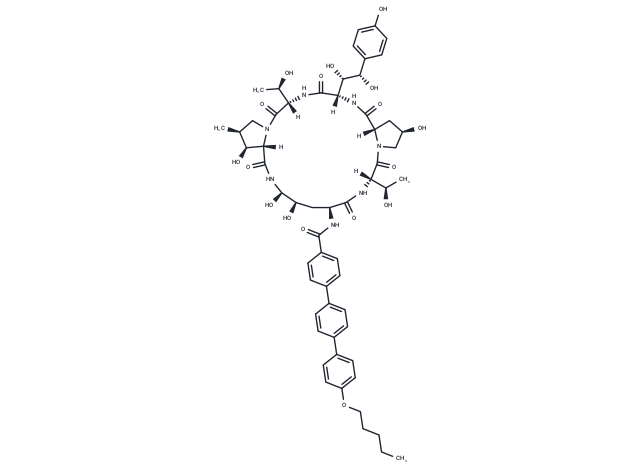Shopping Cart
- Remove All
 Your shopping cart is currently empty
Your shopping cart is currently empty

Anidulafungin (Ecalta) (LY303366) is an echinocandin derivative used as an antifungal drug. It inhibits glucan synthase activity.

| Pack Size | Price | Availability | Quantity |
|---|---|---|---|
| 2 mg | $33 | In Stock | |
| 5 mg | $52 | In Stock | |
| 10 mg | $98 | In Stock | |
| 25 mg | $169 | In Stock | |
| 50 mg | $261 | In Stock | |
| 100 mg | $365 | In Stock | |
| 1 mL x 10 mM (in DMSO) | $123 | In Stock |
| Description | Anidulafungin (Ecalta) (LY303366) is an echinocandin derivative used as an antifungal drug. It inhibits glucan synthase activity. |
| In vitro | Anidulafungin (LY-303366) demonstrates potent in vitro antifungal activity, with minimum inhibitory concentrations (MICs) of ≤0.32 μg/mL against all isolates of Candida albicans (n=99), Candida glabrata (n=18), and Candida tropicalis (n=10). It exhibits significant efficacy against Aspergillus species with a minimum effective concentration (MEC) of 0.02 μg/mL for 90% inhibition (n=20). However, its activity is reduced against Candida parapsilosis (MIC90, 5.12 μg/mL) (n=10), and it is ineffective against C. neoformans (MIC90 >10.24 μg/mL) (n=15) and B. dermatitidis (MIC90, 16 μg/mL) (n=29). Compared to fluconazole, anidulafungin retains low MICs (0.08 to 1.28 μg/mL) against fluconazole-resistant Candida strains, demonstrating a broad range of action. Strains showing resistance to CD101 exhibit a corresponding increase in MIC for anidulafungin and/or caspofungin, highlighting cross-resistance. This strong antifungal activity, notably against Candida species and Aspergillus, contrasts with its limited effects against C. neoformans and B. dermatitidis, for which ketoconazole and amphotericin B show superior efficacy. |
| Kinase Assay | FITC-S1P quantification/Caliper assay: A 384-well format of the SphK enzyme assay based on separation of FITC-S1P from unreacted FITC-sphingosine substrate using a microfluidic capillary electrophoresis mobility-shift system is developed. Briefly, 3 nM SphK1–His6 is incubated with 1 μM FITC-sphingosine, 20 μM ATP and 10 μM compound (a final concentration of DMSO of 2 %) in a buffer containing 100 mM Hepes (pH 7.4), 1 mM MgCl2,0.01% Triton X-100, 10% glycerol, 100 μM sodium orthovanadate and 1 mM DTT for 1 h in a 384-well Matrical MP-101-1-PP plate. Reaction mixtures (10 μL) are quenched by the addition of 20 μL of 30 mM EDTA and 0.15% Coating Reagent-3 in 100 mM Hepes, and a small aliquot of each reaction (a few nanolitres) is analysed in the Caliper LabChip 3000 instrument under -1.5 psi (psi=6.9 kPa) pressure, a downstream voltage of -1900 V and a sip time of 0.2 s. Phosphorylated fluorescent product and unphosphorylated fluorescent substrate appeared as distinctive peaks and are quantified using the Caliper data. |
| Cell Research | Anidulafungin is dissolved in DMSO and stored, and then diluted[2]. Stocks of CD101 (formerly SP 3025, biafungin, AF-025) are prepared fresh in 100% DMSO prior to use. The comparator antifungals Anidulafungin (ANF), Caspofungin (CSF), and Amphotericin B (AMB) are also prepared in 100% DMSO. MIC assays are performed via broth microdilution in accordance with CLSI guidelines, with the exception that test compounds are made up at a 50× final assay concentration and 100 μL assay mixture volumes are used (2 μL added to 98 μL of broth containing cells at 0.5×103 to 2.5×103 CFU/mL). All MIC assays are run at least three times, and a representative data set is shown. Quality control (QC) is assessed throughout the study via comparison of MIC values derived for WT C. krusei strain ATCC 6258 for AMB, CSF, and ANF with previously reported CLSI 24-h broth microdilution QC ranges[2]. |
| Alias | LY303366, Eraxis, Ecalta |
| Molecular Weight | 1140.24 |
| Formula | C58H73N7O17 |
| Cas No. | 166663-25-8 |
| Smiles | [H][C@@]12C[C@@H](O)CN1C(=O)[C@@]([H])(NC(=O)[C@H](C[C@@H](O)[C@@H](O)NC(=O)[C@]1([H])[C@@H](O)[C@@H](C)CN1C(=O)[C@@]([H])(NC(=O)[C@@]([H])(NC2=O)[C@H](O)[C@@H](O)c1ccc(O)cc1)[C@@H](C)O)NC(=O)c1ccc(cc1)-c1ccc(cc1)-c1ccc(OCCCCC)cc1)[C@@H](C)O |
| Relative Density. | 1.47g/cm3 |
| Storage | store at low temperature | Powder: -20°C for 3 years | In solvent: -80°C for 1 year | Shipping with blue ice. | ||||||||||||||||||||||||||||||
| Solubility Information | H2O: < 1 mg/mL (insoluble or slightly soluble) DMSO: 93 mg/mL (81.56 mM), Sonication is recommended. Ethanol: < 1 mg/mL (insoluble or slightly soluble) | ||||||||||||||||||||||||||||||
Solution Preparation Table | |||||||||||||||||||||||||||||||
DMSO
| |||||||||||||||||||||||||||||||

Copyright © 2015-2025 TargetMol Chemicals Inc. All Rights Reserved.